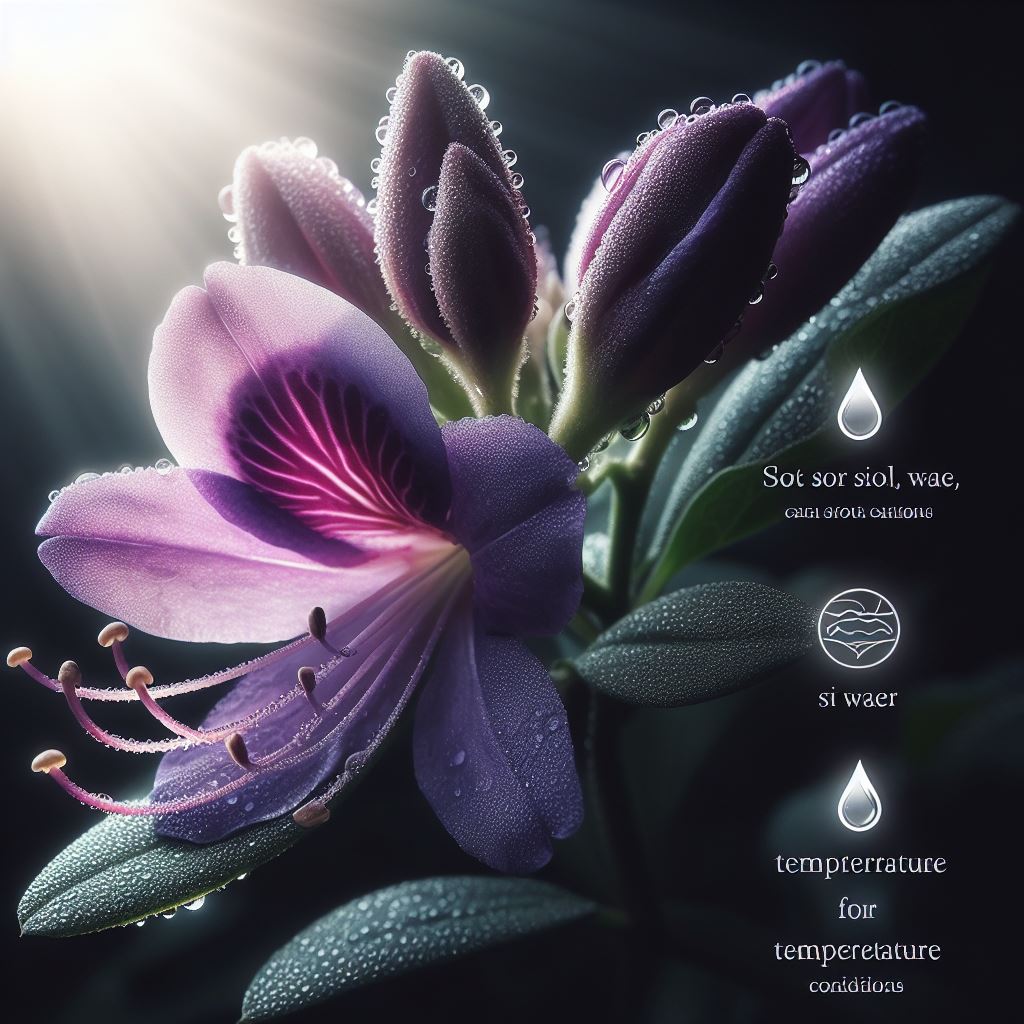Purple honeysuckle, a captivating and alluring flowering plant, has a rich history and a variety of fascinating characteristics. From its vibrant hues to its enchanting fragrance, there is much to discover about this beautiful plant. In this blog post, we will delve into the history, growing conditions, different varieties, benefits, and care tips. Whether you are a seasoned gardener or just starting out, learning about honeysuckle will surely pique your interest and inspire you to cultivate its beauty in your own garden.
The History of Purple Honeysuckle
Purple honeysuckle, scientifically known as Lonicera periclymenum, has a rich history dating back centuries. Here is a brief overview of its fascinating journey through time:

Ancient Roots: The has been admired for its beauty and fragrance since ancient times. It was often mentioned in literature, art, and folklore, symbolizing love, happiness, and the sweetness of life.
Medicinal Uses: Historically, various parts of the purple honeysuckle plant were used in traditional medicine for their healing properties. Its flowers, leaves, and stems were believed to possess anti-inflammatory, diuretic, and expectorant qualities.
Cultural Significance: In many cultures, purple honeysuckle was revered for its mystical and enchanting aura. It was associated with mythical tales, rituals, and celebrations, adding to its allure and charm.
Botanical Discoveries: As botany developed, the purple honeysuckle species and its diverse varieties captured the attention of scientists and horticulturists. The plant’s unique features and adaptability fascinated botanists, leading to further exploration and cultivation.
Modern Cultivation: Today, purple honeysuckle continues to captivate gardeners and enthusiasts worldwide. Its rich history and enduring appeal make it a beloved addition to gardens, landscapes, and floral arrangements.
The timeless allure of the purple honeysuckle continues to thrive, blending its historical significance with its contemporary charm, making it a beloved botanical treasure.
Characteristics of Purple Honeysuckle
Purple honeysuckle, also known as Lonicera sempervirens, is a stunning flowering plant with unique characteristics that make it a popular choice for gardens and landscapes. Here are some key characteristics of this enchanting plant:

- Vibrant Blooms: produces clusters of tubular, fragrant flowers in varying shades of purple, attracting butterflies, hummingbirds, and bees.
- Evergreen Foliage: The plant is adorned with lush, dark green leaves throughout the year, adding a touch of beauty to the garden even in winter.
- Hardiness: Purple honeysuckle is a hardy plant, tolerant of various soil types and weather conditions, making it adaptable to different environments.
- Vining Habit: This honeysuckle variety is a twining vine, perfect for climbing trellises, arbors, and fences, creating a picturesque display of colorful blooms and foliage.
- Fragrance: The flowers emit a sweet, appealing fragrance, enhancing the sensory experience of any outdoor space where they are planted.
- Attracts Wildlife: Apart from its visual appeal and aroma, purple honeysuckle is a magnet for different pollinators, contributing to the biodiversity of the surrounding area.
Comparison Table: Purple Honeysuckle vs. Other Varieties
| Characteristic | Purple Honeysuckle | Other Varieties |
|---|---|---|
| Flower Color | Shades of purple | Various colors |
| Foliage | Evergreen | Deciduous |
| Vine Type | Twining | Twining or trailing |
| Fragrance | Sweet | Varies |
| Wildlife Attraction | Butterflies, | Birds, insects |
| hummingbirds, bees |
In summary, the characteristics of purple honeysuckle make it a desirable addition to any garden, offering visual appeal, fragrant blooms, and ecological benefits.
Best Growing Conditions for Purple Honeysuckle
When it comes to cultivating the enchanting purple honeysuckle, providing the ideal growing conditions is essential for its health and vibrancy. Here are the best growing conditions for your purple honeysuckle:

Sunlight: Purple honeysuckle thrives in full sun to partial shade. Aim for at least 6 hours of sunlight daily for optimal growth and blooming.
Soil: Well-drained, fertile soil with a slightly acidic to neutral pH level is ideal for purple honeysuckle. It’s crucial to ensure good drainage to prevent waterlogged soil, which can lead to root rot.
Water: While established purple honeysuckle plants are quite drought-tolerant, regular watering is essential, especially during dry spells. Aim for consistent moisture without waterlogging the soil.
Temperature: Purple honeysuckle prefers moderate temperatures, making it suitable for growing in USDA hardiness zones 4 to 9. Protect the plant from extreme heat or cold, especially during its early growth stages.
Spacing: When planting purple honeysuckle, ensure proper spacing of about 5 to 10 feet between each plant to allow for adequate air circulation and prevent overcrowding.
By providing the right growing conditions, you can ensure that your purple honeysuckle flourishes and graces your garden with its captivating beauty.
Remember, creating a suitable environment for your purple honeysuckle is essential for its overall well-being and longevity.
Are there purple honeysuckles?
Yes, there are indeed purple honeysuckles, and they are a gorgeous addition to any garden. These varieties display stunning clusters of purple-hued blossoms that are not only visually appealing but also attract pollinators like butterflies and hummingbirds.

Types of Purple Honeysuckles:
Lonicera periclymenum ‘Serotina’: This type features fragrant, tubular-shaped flowers in various shades of purple, creating a picturesque display in any garden.
Lonicera x tellmanniana: Known for its deep purple and gold flowers, this variety offers a unique color combination that adds a touch of elegance to the landscape.
Lonicera sempervirens ‘John Clayton’: While not entirely purple, this cultivar boasts vibrant and attractive purple-tinged blooms that stand out against the green foliage.
Comparison Table of Purple Honeysuckle Varieties:
| Variety | Flower Color | Fragrance Level | Attracts |
|---|---|---|---|
| L. periclymenum ‘Serotina’ | Various shades of purple | Highly fragrant | Butterflies, hummingbirds |
| L. x tellmanniana | Deep purple and gold | Sweet fragrance | Bees |
| L. sempervirens ‘John Clayton’ | Purple-tinged blooms | Mild fragrance | Hummingbirds, bees |
It’s important to note that these purple honeysuckles are not only beautiful but also relatively easy to care for, making them a delightful choice for both novice and seasoned gardeners.
Different Varieties of Purple Honeysuckle
When it comes to purple honeysuckle, there are several captivating varieties that you can consider for your garden. Each variety boasts its own unique features and characteristics, making it an enchanting addition to any landscape. Here are some popular varieties of purple honeysuckle:

Lonicera periclymenum ‘Serotina’ (Late Dutch Honeysuckle): This variety is known for its fragrant, deep purple flowers that bloom in late summer. It’s a vigorous climber and can reach up to 20 feet in height, making it perfect for arbors or trellises.
- Lonicera periclymenum ‘Belgica’ (Early Dutch Honeysuckle):
With its early blooming, sweetly scented, purple and white flowers, this variety adds a delightful pop of color to the garden. It’s a hardy and low-maintenance option for gardeners.
Lonicera periclymenum ‘Scentsation’: This variety is prized for its exceptionally fragrant, two-tone purple and white flowers that attract hummingbirds and butterflies. It’s a compact and non-invasive cultivar, making it ideal for smaller garden spaces.
- Lonicera periclymenum ‘Fragrant Cloud’:
As the name suggests, this variety is renowned for its intensely fragrant, purple blossoms. It’s a vigorous climber, reaching heights of around 15 feet, and its nectar-rich flowers are irresistible to pollinators.
By exploring the diverse varieties of purple honeysuckle, you can select the one that best suits your garden’s requirements and indulge in the beauty and allure of these stunning flowering vines.
Why is Invasive Honeysuckle Bad?
Purple honeysuckle, as enchanting as it may be, can sometimes pose a threat when it becomes invasive. Here’s why invasive honeysuckle is considered bad:

Aggressive Competitor: Invasive honeysuckle, including some purple varieties, tends to outcompete native plants for resources like sunlight, water, and nutrients. This can disrupt the balance of the local ecosystem.
Negative Impact on Biodiversity: When invasive honeysuckle takes over an area, it reduces the biodiversity by crowding out other plant species. This, in turn, affects the wildlife that depends on a variety of plants for food and habitat.
Altered Soil Chemistry: The presence of invasive honeysuckle can alter the soil chemistry, making it less suitable for the growth of native plant species. This can further exacerbate the loss of biodiversity in an area.
Increased Wildfire Risk: Invasive honeysuckle is known to be more flammable than many native plant species, which can increase the risk of wildfires in some regions.
Challenges in Restoration Efforts: Removing invasive honeysuckle can be labor-intensive and costly, posing challenges to ecological restoration efforts in affected areas.
By understanding the potential negative impact of invasive honeysuckle, gardeners and conservationists can make informed decisions about its cultivation and take necessary measures to prevent its spread beyond desired boundaries.
Benefits of Growing Purple Honeysuckle in Your Garden
When it comes to adding a touch of charm to your garden, planting purple honeysuckle can offer numerous benefits. Let’s take a closer look at the advantages of incorporating this vibrant plant into your outdoor space:

Attracts Pollinators: Purple honeysuckle is a favorite among pollinators such as butterflies, bees, and hummingbirds. By including this flowering shrub in your garden, you can create a welcoming environment for these beneficial creatures, thus contributing to the overall health and biodiversity of your garden.
Beautiful Aesthetic: The stunning, tubular-shaped flowers of the purple honeysuckle add a delightful visual appeal to any garden. Whether used as a standalone feature or as part of a floral arrangement, the vibrant purple blooms can elevate the ambiance of your outdoor space.
Low Maintenance: Purple honeysuckle is relatively low-maintenance, making it an ideal choice for gardeners with varying levels of experience. Its resilience and ability to thrive in different conditions make it an attractive option for those seeking an easy-to-care-for plant.
Fragrant Blooms: The aromatic scent emitted by the flowers of purple honeysuckle can fill the air with a sweet, captivating fragrance, enhancing the sensory experience of spending time in your garden.
Erosion Control: As a vining plant, purple honeysuckle can effectively assist in erosion control. Its sprawling growth habit can help stabilize soil on slopes or embankments, thereby preventing erosion and adding an element of natural beauty to these areas.
In conclusion, the addition to your garden can bring a host of benefits, from its visual allure and fragrance to its value in supporting pollinators and aiding in erosion control.
Is Blue Honeysuckle Invasive?
Blue honeysuckle, also known as Lonicera caerulea, has gained popularity among gardeners due to its delicious and nutritious berries. While blue honeysuckle is not considered invasive in the traditional sense, it’s crucial to understand its growth habits and potential impact on the local ecosystem.
Characteristics of Blue Honeysuckle
- Blue honeysuckle plants are generally well-behaved and are not known to aggressively spread or outcompete native plant species.
- Their non-invasiveness makes them an attractive option for gardeners who want to enjoy the benefits of honeysuckle without the risk of introducing an invasive species.
Comparison with Invasive Honeysuckle Species
| Aspect | Blue Honeysuckle | Invasive Honeysuckle |
|---|---|---|
| Growth Habit | Non-aggressive | Aggressively spreads |
| Impact on Ecosystem | Limited | Disrupts native species |
| Containment | Easily managed | Challenging to control |
Cultivation Considerations
- When planting blue honeysuckle, it’s still essential to monitor its growth and prevent it from escaping into natural areas where it could potentially outcompete native plants.
In conclusion, while blue honeysuckle is not classified as invasive, responsible cultivation practices and monitoring are still necessary to ensure it does not pose a threat to the local environment.
Remember, understanding the growth characteristics and environmental impact of any plant, including blue honeysuckle, is essential for maintaining a healthy and balanced ecosystem.
Tips for Caring for Purple Honeysuckle
Caring for purple honeysuckle is relatively straightforward, but it requires attention to specific details to ensure optimal growth and health for these stunning plants. Here are some essential tips for caring:

Sunlight and Water: Thrives in full sun to partial shade. Ensure they receive at least 6 hours of sunlight daily. Water the plants regularly, especially during dry periods. Ensure proper drainage to prevent waterlogging, which can harm the roots.
Soil Requirements: Plant purple honeysuckle in well-draining, fertile soil with a slightly acidic to neutral pH (between 6.0 and 7.0). Consider adding organic matter such as compost to improve soil structure and fertility.
Mulching: Apply a layer of organic mulch, such as wood chips or shredded bark, around the base of the plants. Mulch helps retain soil moisture, suppresses weeds, and regulates soil temperature.
Fertilization: Use a balanced, slow-release fertilizer in early spring to support healthy growth. Avoid over-fertilization, as this can lead to excessive foliage at the expense of flowers.
Pruning: Regular pruning is essential to maintain the shape of the plant, promote airflow, and encourage the growth of new blooms. Prune the plant immediately after flowering to remove dead or overcrowded branches.
Support and Training: Provide a trellis or other support structure for climbing varieties of purple honeysuckle. Train the vines to grow in the desired direction to prevent tangling and promote an attractive form.
By following these caring tips, you can ensure that your purple honeysuckle thrives and continues to enchant with its beautiful blooms and sweet fragrance.
Remember, successful cultivation leads to better growth and lovely blooms.
Common Pests and Diseases Affecting
While beautiful and enchanting, can be susceptible to certain pests and diseases. Here are some common issues to be aware of when caring:
Aphids: These tiny insects can infest the plant, causing damage by sucking sap from the leaves and stems. To combat aphids, regularly inspect the plant and use a strong blast of water to remove them. Introducing natural predators like ladybugs can also help control aphid populations.
Powdery Mildew: This fungal disease appears as a white powdery substance on the leaves, affecting the plant’s overall health. To prevent powdery mildew, ensure proper air circulation around the plant and avoid overhead watering. Fungicidal sprays can be used if the infestation becomes severe.
Leaf Blight: This disease causes dark, sunken lesions on the leaves, eventually leading to defoliation. To manage leaf blight, remove and destroy infected plant material, and ensure proper spacing between plants to improve air circulation.
Spider Mites: These pests can be particularly problematic, causing yellow stippling on the leaves and fine webbing on the plant. Regularly spraying the plant with water can help deter spider mites. Additionally, introducing predatory mites can effectively control their population.
By being vigilant and proactive in addressing these potential pests and diseases, you can help ensure the health and longevity of your plants. Regular monitoring and prompt action will aid in maintaining the enchanting beauty of your garden.
Remember, purple honeysuckle is a beautiful addition to your garden, and by understanding and addressing these common issues, you can enjoy its beauty for years to come.
Pruning Techniques
When it comes to enhancing the scent and overall health of your honeysuckle, proper pruning techniques play a crucial role. Here’s how to ensure your purple honeysuckle emits the strongest scent:
Regular Pruning:
- Frequency: Prune your purple honeysuckle annually, preferably in late winter or early spring before new growth appears.
- Objective: This helps in shaping the plant, controlling its size, and promoting better air circulation.
Removing Deadwood:
- Purpose: Eliminate any dead, damaged, or diseased wood to maintain the overall health of the plant and enhance its fragrance.
Thinning Out:
- Process: Regularly thin out crowded areas to encourage the growth of new, fragrant blooms.
- Result: This allows more sunlight and air to reach the center of the plant, leading to stronger and more aromatic blooms.
Stimulating Growth:
- Technique: Cut back one-third of the oldest stems to the ground to encourage new growth and stimulate stronger fragrance production.
Maintenance:
- Consistent Care: Ensure regular watering, fertilizing, and providing the necessary growing conditions to support the rejuvenation of the plant for a more robust scent.
By applying these pruning techniques, you can promote the growth of fragrant blooms and experience the full aromatic potential of your purple honeysuckle.
Remember that while pruning is essential for enhancing scent, it’s important not to over-prune as this can affect the plant’s overall health and ability to produce flowers.
Pruning Techniques for Purple Honeysuckle
Pruning is essential for maintaining the health and shape of your purple honeysuckle. Proper pruning techniques not only encourage new growth but also help in controlling the size and spread of the plant. Here are some effective pruning techniques for your plants:
Prune in the right season: Prune your purple honeysuckle in late winter or early spring when the plant is still dormant. This is the ideal time as it allows the plant to recover and produce new growth once the growing season begins.
Remove dead and damaged branches: Use clean, sharp pruning shears to remove any dead, diseased, or damaged branches. Cut them back to the nearest healthy bud or branch to promote healthy growth.
Control the size: To maintain the desired size and shape of your purple honeysuckle, selectively prune the longest branches. This will help to control the spread and avoid overcrowding.
Encourage flowering: After the blooming period, prune the flowering stems to shape the plant and encourage new growth. Remove about one-third of the old growth to stimulate the production of new flowering wood.
Regular maintenance: Throughout the growing season, inspect your purple honeysuckle for any unruly growth or tangled branches. Prune as necessary to maintain a neat and healthy appearance.
By following these pruning techniques, you can ensure that your purple honeysuckle remains healthy, vibrant, and a stunning addition to your garden.
Frequently Asked Questions
What is Purple Honeysuckle?
Purple honeysuckle is a flowering vine known for its fragrant purple and pink blossoms. It is a popular choice for gardens and landscapes due to its vibrant colors and sweet aroma.
How do I care for Purple Honeysuckle?
To care for purple honeysuckle, plant it in well-drained soil with full to partial sun exposure. Water regularly and prune after flowering to maintain its shape. It is a low-maintenance plant that thrives in various climates.
When does Purple Honeysuckle bloom?
Purple honeysuckle typically blooms in late spring to early summer. The flowering period can vary depending on the specific variety of plants. The blossoms are known for their captivating and enchanting beauty.
Is Purple Honeysuckle poisonous to pets?
Purple honeysuckle is non-toxic to pets, making it a pet-friendly plant for gardens and outdoor spaces. However, it’s always a good practice to monitor pets around plants and ensure they don’t consume large quantities of foliage or flowers.
Can Purple Honeysuckle be grown in containers?
Yes, purple honeysuckle can be grown in containers, making it a versatile choice for patios, balconies, and small gardens. Choose a large container with good drainage, and provide regular care to ensure the plant thrives in a container environment.






